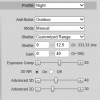That is getting there - still a bit of noise, but could certainly obtain a good capture.
I would suggest to test it under that scenario and see what it looks like with the door up to simulate the situation - does the outside introduce any ambient light to improve the image or does it create a backlight situation that shadows the perp, etc.
I would then consider a motion trigger very close to the entrance of the garage so that someone doesn't have to go far for the lights to kick on.
I would suggest to test it under that scenario and see what it looks like with the door up to simulate the situation - does the outside introduce any ambient light to improve the image or does it create a backlight situation that shadows the perp, etc.
I would then consider a motion trigger very close to the entrance of the garage so that someone doesn't have to go far for the lights to kick on.









